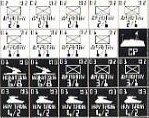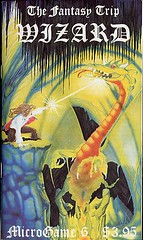12:06 AM
Metagaming Microgame Nostalgia, Part 1
Mister Nizz
Metagaming, a fond look backward
I found a big old box of the old Metagaming Micros in a box downstairs on Friday, and that got the old nostalgic notions going about these games. Metagaming essentially created the concept of the "microgame", a proletarian niche that I always liked (see also: Microgame FAQ). They were published between 76 and 82. They were cheap, usually boasting a folded 11 x 17 map with strip-cut, incredibly cheap counters, sometimes crude artwork, and rules that were usually typeset with an IBM selectric typewriter. The basic concept behind the microgame line was minimal components, almost disposable price, and low complexity game rules. The subjects of the games covered the waterfront, from fantasy to science fiction to history. There's something about that "Small is Beautiful" concept that I still love, these many years later.
So I thought I'd do a "look backward" at some of these, and try to recollect what was good and what was absolute crap, in a small series of posts. I won't be presenting these pieces in any discernible order, mind you, just as they come to me.
Preamble: Metagaming was a small game company from Austin, Texas that started up in the "boom time" of gaming, back in the late 70s. The head of the company, Howard Thompson, published his first game, Stellar Crusade, in big box format, then hit upon the idea of small, low-cost (usually 2.95 back then) ziploc games in the format described above. The first game published was a doozy, a little tank game named OGRE. The format proved to be popular for a while, until increasing competition from RPGs and other market forces caused the company to hit upon hard times in the early 80s. Metagaming folded its tent in 1982, and Howard Thompson dropped out of the gaming scene permanently. Howard seems to have been quite a character; there are many stories floating around about his behavior and feelings about the industry. At this date, the issue of the Metagaming copyrights seems to be unclear at best, as this correspondent reports. I know that Steve Jackson, at least, has made the wise decision to retain his intellectual property (Ogre and GEV, thought he did not retain rights for Melee). I couldn't begin to guess about the other games.
It seems fitting to start with the two best sellers in the line-up before we get to the obscure stuff.
1. OGRE: Metagame #1
(later published by Steve Jackson Games, and copyright is still held by that company). For assistance with figuring out what version you have, check the OGRE LUDOGRAPHY published on that site, it's very helpful.

The first and probably most succesful of the designs of Metagaming was OGRE, a science fiction David and Goliath situation where a giant cybernetic tank (based on the BOLO series by Keith Laumer, among other sources) is attacking a futuristic command post, with a host of smaller units, customizable by the defending player on a point purchase basis.

The giant tank is an amalgamation of a bunch of systems, from tracks to weapons to missiles, etc., each of which has to be overcome by attacks by the defenders, or the Command Post is toast. Playing the Ogre can be very linear and is oftimes uninteresting (to me at least), but it does make for a very good solitaire game, as long as you play against the Ogre (even an Ogre that doesn't try to dodge around and avoid long range howitzers will be an impressive opponent just by ploughing straight ahead toward the objective). Obviously the more fun side to play is the defender, who has to determine what forces to buy and where to place them on the map. The defender KNOWS he will lose units (in droves) so he has to know where on the board to place them so that his little "speed bumps" will be the most effective. A great little game, somewhat unbalanced in favor of the defender (believe it or not!).
Variations exist-- many versions of OGRE (and the ground warfare sequel, GEV, which will be the subject of a follow-on post) were printed, but the basic rules stayed the same throughout most of the game's existence. The game OGRE MINIATURES is played somewhat differently than the games DELUXE OGRE and DELUXE GEV, even though the latter games involved miniatures as gaming pieces vice counters.
Note: I even wrote a variant for OGRE, myself! It's a what if situation involving OGRE on the moon, called OGRELUNA. This was later copied (with my blessing) as OGRE on MARS.
See Also: Command Post Gamma, Datapulse, and the OGRE Mailing List.
You CAN play OGRE/GEV pbem via Cyberboard, with Steve Jackon's blessing.
Addition: OGRE has its very own WIKIPEDIA entry, and it is very well done!
2. Melee: Metagame #3 and Wizard: Metagaming #6
The first of a series of a roleplaying series of modules that eventually became known as THE FANTASY TRIP. Later, another modules named Wizard was added that brought magic into the game. Melee only dealt with very basic man to man (and man to monster) combat. It was a funky, easy RPG-- easy to learn, easy to teach, without D&D's excessive rules bloat. I always liked TFT. There's only three stats to learn, and maybe one sheet of charts to carry around. The hex map basis of the game made it more of a miniatures skirmish rules set than a D&D rule set. We played the heck out of Melee over the years, and I bought several sets.

I'm adding Wizard to this article becaue I've always considered the two games to be inseperable. The first module introduces basic stats of STR (Strength) and DEX (Dexterity) and the two of those make MA (Movement Allowance). Wizard added IN (Intelligence), the prima statistic for casting spells with. The counter sheet in Wizard was a bit funkier than the one in Melee... there were far more multihex or giant class monsters to kill in Wizard, many of which made it to the cut sheet. Melee, by contrast, focused on basic hand to hand combat so its countersheet was all fighters and weapons. The map in both games was very similar, with Wizard's being slightly larger.
Melee/Wizard went on to morph into Advanced Melee, Advanced Wizard, and Into the Labyrinth, all full-sized expansions to the RPG series (that I probably won't touch upon in this series, as they weren't micro sized or micro priced) however, if you have any interest, check here. TFT, in turn, morphed into GURPS when Steve Jackson broke off his relationship with Metagaming and started his own company. The first GURPS module, GURPS Man to Man, reminds me strongly of Advanced Melee.

The artwork for Melee/Wizard was ten times funkier (by TSR D&D standards) and far more generic in terms of setting and theme, but the "bang you got for your buck" was very commendable.

See Also: TFT Mailing List HQ, "The Fantasy Trip" fansite (really just a shameless front end for "Dark City Games"), Ty Beard's TFT page. David Miller just did a new Melee/Wizard Tribute site, although not much is on it at the moment. Shore is purty, though.
You CAN play Melee (and Wizard) PBeM style, via Cyberboard.
Addition: TOURNAMENT MELEE (Dan Becker website)
Fantasy Trip Entry in Wikipedia
(Next time: Warp War and Olympica, two great SF games at a bargain basement price.)
1 OGRE and Melee
2 WarpWar and Olympica
3 Starleader: Assault, Chitin:I and Dimension Demons
4 Rivets and Black Hole
5 G.E.V. and Holy War
6 Ice War, Annihilator/One World, and Hot Spot
7 Invasion of the Air Eaters and Artifact
8 Trailblazer, Helltank/Helltank Destroyer, and Lords of the Underearth